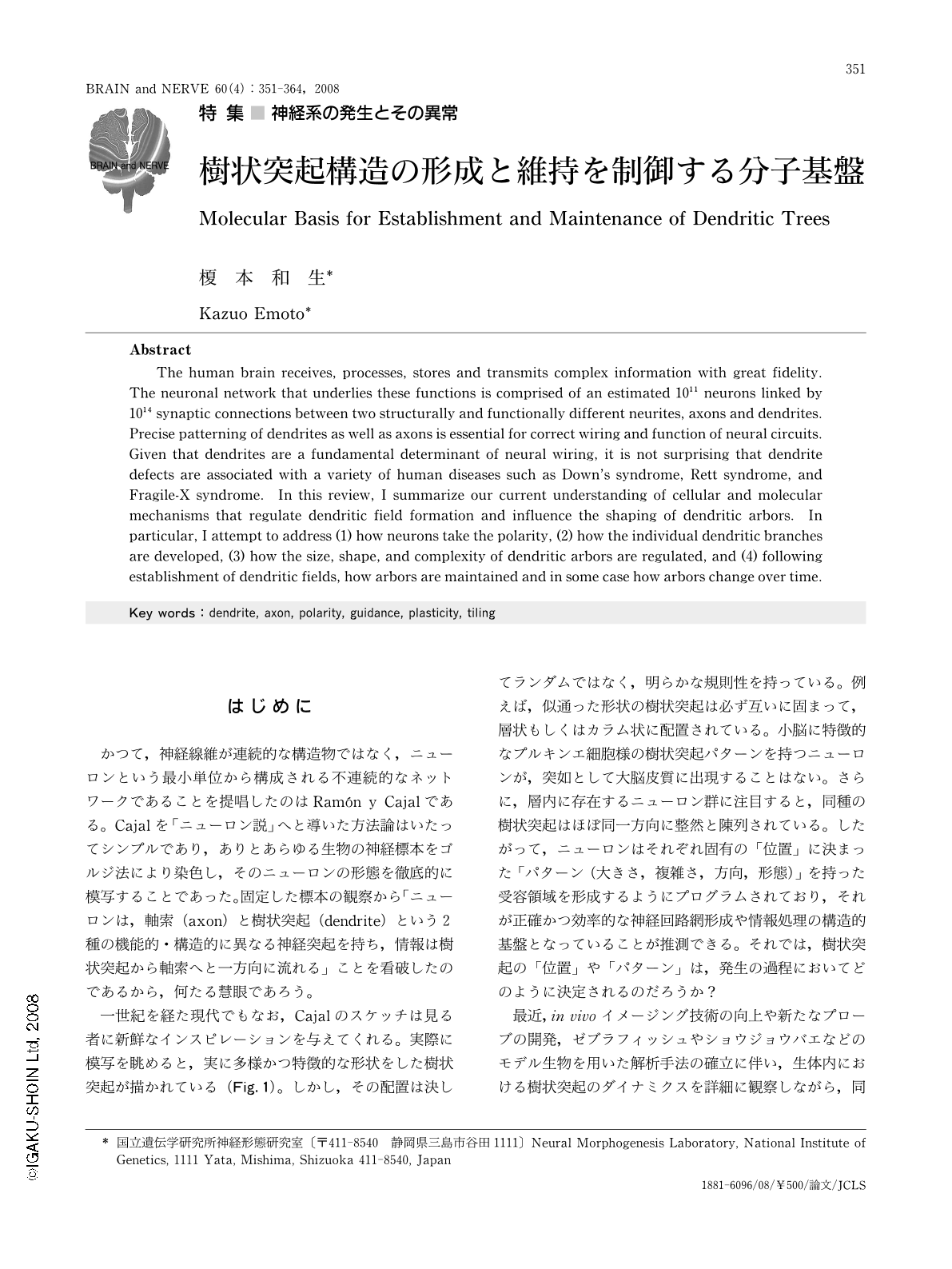Japanese
English
- 有料閲覧
- Abstract 文献概要
- 1ページ目 Look Inside
- 参考文献 Reference
はじめに
かつて,神経線維が連続的な構造物ではなく,ニューロンという最小単位から構成される不連続的なネットワークであることを提唱したのはRamon y Cajalである。Cajalを「ニューロン説」へと導いた方法論はいたってシンプルであり,ありとあらゆる生物の神経標本をゴルジ法により染色し,そのニューロンの形態を徹底的に模写することであった。固定した標本の観察から「ニューロンは,軸索(axon)と樹状突起(dendrite)という2種の機能的・構造的に異なる神経突起を持ち,情報は樹状突起から軸索へと一方向に流れる」ことを看破したのであるから,何たる慧眼であろう。
一世紀を経た現代でもなお,Cajalのスケッチは見る者に新鮮なインスピレーションを与えてくれる。実際に模写を眺めると,実に多様かつ特徴的な形状をした樹状突起が描かれている(Fig.1)。しかし,その配置は決してランダムではなく,明らかな規則性を持っている。例えば,似通った形状の樹状突起は必ず互いに固まって,層状もしくはカラム状に配置されている。小脳に特徴的なプルキンエ細胞様の樹状突起パターンを持つニューロンが,突如として大脳皮質に出現することはない。さらに,層内に存在するニューロン群に注目すると,同種の樹状突起はほぼ同一方向に整然と陳列されている。したがって,ニューロンはそれぞれ固有の「位置」に決まった「パターン(大きさ,複雑さ,方向,形態)」を持った受容領域を形成するようにプログラムされており,それが正確かつ効率的な神経回路網形成や情報処理の構造的基盤となっていることが推測できる。それでは,樹状突起の「位置」や「パターン」は,発生の過程においてどのように決定されるのだろうか?
最近,in vivoイメージング技術の向上や新たなプローブの開発,ゼブラフィッシュやショウジョウバエなどのモデル生物を用いた解析手法の確立に伴い,生体内における樹状突起のダイナミクスを詳細に観察しながら,同時にその分子基盤を同定することが可能となってきた。その結果,ニューロンは,自身が持つ遺伝情報に加えて,細胞外からの情報に依存して受容領域の「位置」や「パターン」を決定することが明らかとなり,その分子基盤に関する理解も進んでいる。また,ニューロンが一度受容領域を確定させると,それを積極的に「維持」するメカニズムが作動することも示唆されつつある。本稿では,技術革新に伴い明らかになってきたニューロンの固有の樹状突起構造を獲得し,それを維持するメカニズムについて,最近の知見を取り上げて概説する。なお,誌面の都合上,スパイン(spine)の形成・維持機構については触れない。興味ある方は,最近の優れた総説1,2)を参考にされたい。
Abstract
The human brain receives, processes, stores and transmits complex information with great fidelity. The neuronal network that underlies these functions is comprised of an estimated 1011 neurons linked by 1014 synaptic connections between two structurally and functionally different neurites, axons and dendrites. Precise patterning of dendrites as well as axons is essential for correct wiring and function of neural circuits. Given that dendrites are a fundamental determinant of neural wiring, it is not surprising that dendrite defects are associated with a variety of human diseases such as Down's syndrome, Rett syndrome, and Fragile-X syndrome. In this review, I summarize our current understanding of cellular and molecular mechanisms that regulate dendritic field formation and influence the shaping of dendritic arbors. In particular, I attempt to address (1) how neurons take the polarity, (2) how the individual dendritic branches are developed, (3) how the size, shape, and complexity of dendritic arbors are regulated, and (4) following establishment of dendritic fields, how arbors are maintained and in some case how arbors change over time.

Copyright © 2008, Igaku-Shoin Ltd. All rights reserved.


